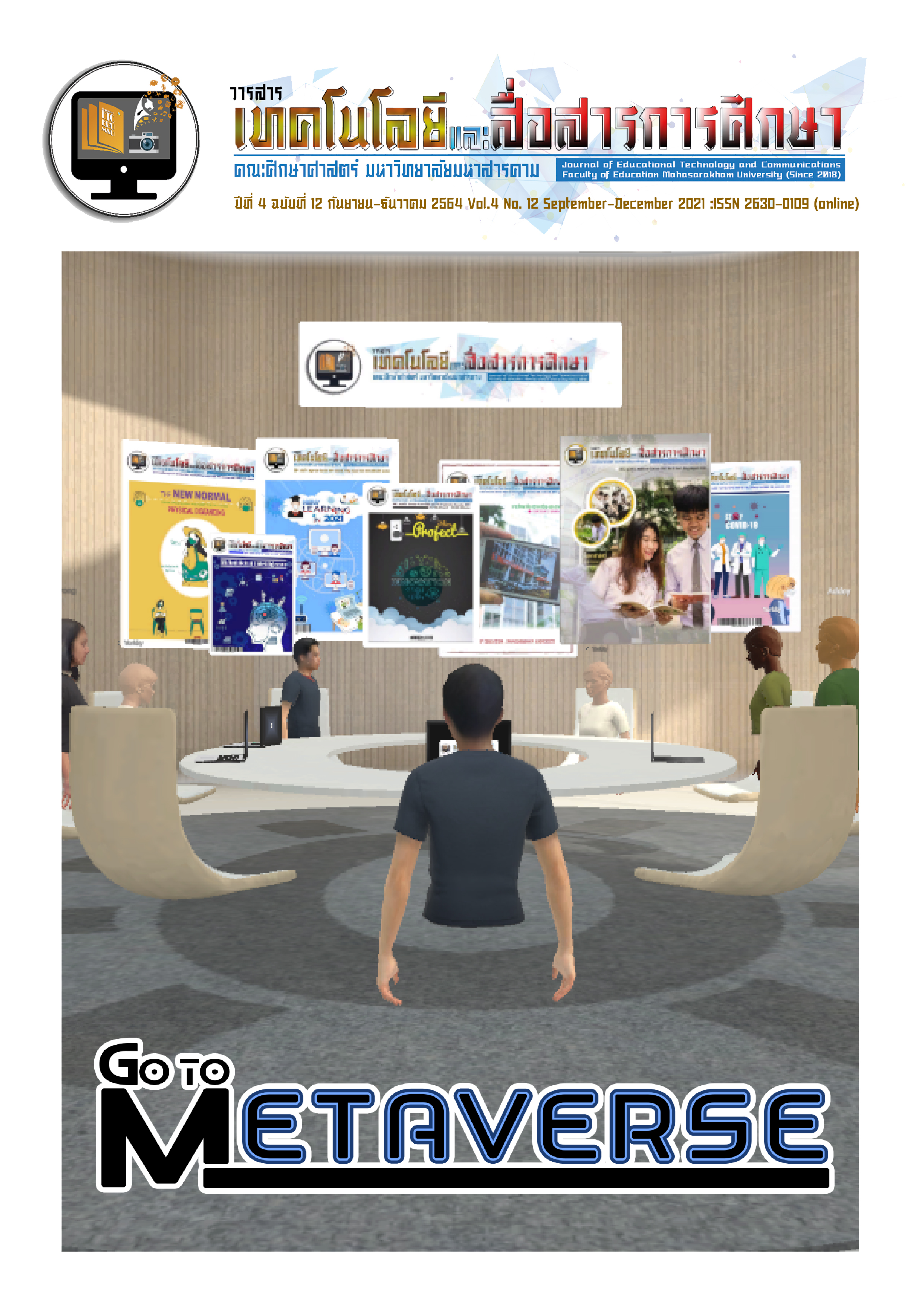Developing Recognition Ability and Retention in Thai Consonant through Learning Activities with Imagery and Storytelling for Early Childhood Students
Main Article Content
Abstract
The purpose of this experimental research was 1) to compare Thai consonant recognition ability of early childhood students by using activities with Imagery and Storytelling with the 70% set criteria, 2) to study the retention of Thai consonant recognition of early childhood students through imagery and storytelling activities by comparing scores between the first and the second tests. 3) to observe early childhood students’ learning behaviors on Thai Consonant recognition through the imagery and storytelling activities.
The sample being used were 17 of early childhood students of kindergarten 1 at Thai-international School, Pathumthani. The sample of this research was drawn through Cluster random sampling. The research instruments were 1) Lesson plans, 2) Thai consonant recognition ability tests, and 3) Thai consonants learning behavior observation form. The data were analyzed by percentage, mean, standard deviation, t-test for Dependent samples and t-test for One sample.
The result shown that 1) For the posttest on Thai consonant abilities, all students passed the criterion score at 70 percentage, significantly at the .05 level (sig.=.000, t=5.237*); 2) for investigation on retention in Thai consonants recognition ability of the Early childhood students through the imagery and storytelling activities, the second test was conducted 2 weeks after the first test had been done. The score of second test was higher than that of the first test at the .05 level of significance (sig.=.014, t=2.762*); 3) Learning behavior of the Early childhood students was at the high level.
Downloads
Article Details
References
กมลรัตน์ หล้าสุวงษ์. ( 2528 ). จิตวิทยาการศึกษา. กรุงเทพฯ: มหาวิทยาลัยศรีนครินทรวิโรฒ.
กุลวรา ชูพงศ์ไพโรจน์, (2535). เทคนิคการเล่านิทานในเทคนิคน่ารู้ควรคู่แก่เด็กปฐมวัย. กรุงเทพฯ
--------. (2561). นิทานผสานอักษร เล่ม 1 ก ถ ภ ฎ ฏ. กรุงเทพฯ: อักษร เนกซ์.
--------.(2561). นิทานผสานอักษร เล่ม 2 ข ช. กรุงเทพฯ: อักษร เนกซ์.
--------. (2561). นิทานผสานอักษร เล่ม 3 บ ป ษ. กรุงเทพฯ: อักษร เนกซ์.
---------. (2561). นิทานผสานอักษร เล่ม 7 ผ ฝ ย. กรุงเทพฯ: อักษร เนกซ์.
ฉวีวรรณ กินาวงศ์. (2543). การศึกษาเด็ก. กรุงเทพฯ: โอเดียนสโตร์.
ชนาทิป บุปผามาศ. (2553). การคิดเชิงเหตุผลของเด็กปฐมวัยที่ได้รับจากการจัดกิจกรรมการเล่านิทานประกอบคำถาม. วิทยานิพนธ์มหาบัณฑิต มหาวิทยาลัยศรีนครินทรวิโรฒ.
ชัยพร วิชชาวุธ. (2520). ความจำของมนุษย์. กรุงเทพฯ: จุฬาลงกรณ์มหาวิทยาลัย.
ณัฐพร กองสิน. (2562). การออกแบบสื่อกราฟิกเคลื่อนไหว 2 มิติ เพื่อช่วยในการจำพยัญชนะไทย. วิทยานิพนธ์ปริญญามหาบัณฑิต. มหาวิทยาลัยรังสิตุ.
ทิพรัตน์ สัตระ. (2549). ผลการใช้เทคนิคผังกราฟิกในการสอนวิทยาศาสตร์ที่มีต่อผลสัมฤทธิ์ทางการเรียนและความคงทนในการเรียนรู้ของนักเรียนชั้นมัธยมศึกษาปีที่ 2. วิทยานิพนธ์ปริญญามหาบัณฑิตสาขาวิชาหลักสูตรและการสอน. มหาวิทยาลัยราชภัฏนครสวรรค์์.
ธริตา นาคสวัสดิ์. (2558). การเล่านิทานประกอบภาพเพื่อพัฒนาความสามารถในการเขียนสะกดคำที่ประสมด้วยสระเปลี่ยนรูปของเด็กที่มีความบกพร่องทางการเรียนรู้. วิทยานิพนธ์ปริญญาศึกษามหาบัณฑิต. มหาวิทยาลัยศิลปากร.
บุญชม ศรีสะอาด. (2556). วิธีการทางสถิติสําหรับการวิจัย เล่ม 1. พิมพครั้งที่ 5. กรุงเทพฯ: สุวีริยาสาสน์.
ผกาพันธ์ เชฏฐาวิวัฒนา. (2560). การเขียนพยัญชนะไทยของนักเรียนชั้นอนุบาล 2 จากการใช้รูปภาพประกอบกิจกรรมศิลปะสร้างสรรค์. วิทยานิพนธ์ปริญญามหาบัณฑิต. มหาวิทยาลัยนอร์ทกรุงเทพ.
วาโร เพ็งสวัสดิ์. (2544). การวิจัยการศึกษาปฐมวัย. กรุงเทพฯ: สุวีริยาสาสน์.
ศรีวิไล เชาว์ปรีชา. (2550). การศึกษาพฤติกรรมความสุขของเด็กปฐมวัยโดยใช้กิจกรรมคุณค่าเพื่อชีวิต. วิทยานิพนธ์ปริญญา
มหาบัณฑิต. มหาวิทยาลัยศรีนครินทรวิโรฒ.
สมศักดิ์ ปริบุรณะ. (2550). นิทาน ความสำคัญและประโยชน์. ราชบุรี: สถาบันราชภัฏหมู่บ้านจอมบึง.
อารีญา เชี่ยวจอหอ. (2551). การใช้การเล่าเรื่องเพื่อเพิ่มความสามารถด้านการฟังภาษาอังกฤษของนักเรียนชั้นประถมศึกษาปีที่ 3
โรงเรียนอัสสัมชัญคอนแวนต์ สีลม. วิทยานิพนธ์ปริญญามหาบัณฑิต. มหาวิทยาลัยศรีนครินทรวิโรฒ.
Adams, J.A. (1967). Human Memory. New York: McGrew-Hill Book Company.
Aiex, N.K. (2006). Storytelling by Children. [online] Available from http://www.vtaide.com/png1ERIC/ Storytelling.htm [accessed October 13, 2020].
Allahmoradi, N. (2018). The Effect of Imagery Strategy on Learning Vocabulary Among Elementary Students of Iran., M.A., Ilam University, IRAN.
Atkinson, R.C.& Shiffrin, R.M. (1968). Human Memory: A Proposed System and Its Control Processes.
The Psychology of Learning and Motivation, pp.89-195. New York. Academic Press.
Avgerinou, M.D.& Pettersson, R. (2011). Toward a Cohesive Theory of Visual Literacy. Journal of visualliteracy. 30(2), 1-19.
Bloom, B.S. (1976). Human Characteristics and School Learning. New York: McGraw-Hill Book Company.
Barton, K. (2013). Literacy and Dramatic Play: Storytelling with Props Increases Preschool Children’s Language Skills During Play. Alabama. University of Alabama. [online] Available from https://ir.ua.edu/ handle /12345 6789/1780 [accessed October 15, 2020].
Brown, & Cocking. (1999). How People Learn: Brain, Mind, Experience, and School. Washington, D.C.: National Academy Press. [online] Available from https://www.nap.edu/read/9853/chapter/1#ix [accessed October 15, 2020].
Chiara, F.T., Sara, A., Giulia, C. & Veronica, M. (2020). Learning by task repetition enhances object individuation and memorization in the elderly. Scientific Reports vol 10.
Coyle, Y., & Gomez Gracia, R. (2014). Using Songs to Enhance L2 Vocabulary Acquisition in Preschool Children. ELT Journal, 68(3), 276-285.
Dossey, B.M. (1997). Imagery in Core Curriculum for Holistic Nursing. Gaithersburg, Md: Aspen Publishers. Fuchs, L., Compton, D.L., Powell, S.R., Seethaler, P.M., Cappizzi, A.M., Schatschneider, C., & Fletcher,
J.M. (2006). The Cognitive Correlates of Third-Grade Skill in Arithmetic, Algorithmic Computation, and Arithmetic Word Problems. Journal of Educational Psychology 98(1), 29-43.
Gall, M. D., Borg, W. R., and Gall, J. P. (1996). Educational Research: An Introduction. Longman Publishing, New York.
Ishai, A., & Sagi, D. (1997). Visual imagery: Effects of Short- and Long-Term Memory. Journal of Cognitive Neuroscience, 9(6), 734–742.
Keogh, R., & Pearson, J. (2011). Mental imagery and visual working memory. PLoS ONE, 6(12), Article e29221.[online] Available from https://doi.org/10.1371/journal.pone.0029221 [accessed October 16, 2020].
Li-Yuan Wu. (2013). Children’s play and symbolic representation.National University of Tainan. Review of Global Management and Service Science, Vol. 3, 2013.
Malkina, N. (1995). Story telling in Early Language Teaching Russia. [online] Available from www//exchange.stage.gov/forum/vols/ vol00/no1/P38.htm [accessed October 16, 2020].
Marzano, R.J. (2001). Designing a New Taxonomy of Educational Objectives. Experts in Assessment. Thousand Oaks, California: Corwin Press.
Maydeu-Olivares, A. (2004). Thurstone Case V Model: A Structural Equations Modeling Perspective. Modeling Perspective, pp. 41-66.
Meesat, P. (2015). Somatically Enhanced Approach (SEA) in Intensive Thai Course for Academic Purposes. An Unpublished Ph.D. Thesis of the University of Canberra, Canberra.
Piaget, J. (1969). Biology and knowledge. Chicago: University of Chicago Press. Quak, M., London,
R. E., & Talsma, D. (2015). A Multisensory Perspective of Working Memory. Journal Frontiers in Human Neuroscience, Vol 9.
Stephens, R. L. (1993). Imagery: A Stragic Intervention to Empower Clients Part I-review of Research Literature. Clinical Nurse Specialist, 7(4), 170- 174.
Tiernan, P. J. (1994). Independent Nursing Interventions: Relaxation and Guided Imagery in Critical Care. Critical Care Nurse, 14(5), 47-51.
Thurstone, L.L. (1958). Primary Mental Abilities. Chicago : University of Chicago.
Yushinta, A., Sukarmin, & Suharno. (2020). Analysis of Student’s Creative Thinking Skills Profiles on Work and Energy Topics. AIP Conference Proceeding 2296. [online] from ttps://aip.scitation.org/doi/abs/10.1063/5.0030396 [Retrieved October 16, 2020].

